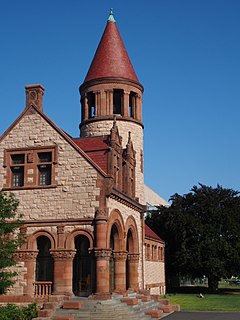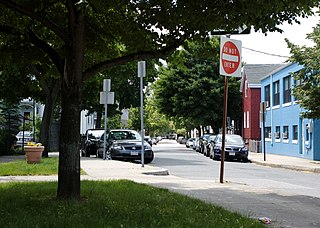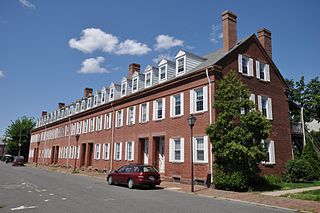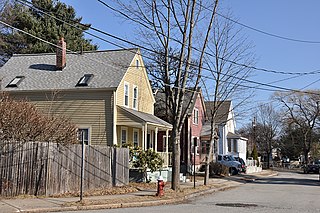
South Park is a 24-block, 150-acre area of more than 780 structures primarily dating from the 1880s to the early twentieth century. It is located south of downtown Dayton, Ohio, just north of the University of Dayton campus and Woodland Cemetery, and east of Miami Valley Hospital. Mainly residential in character, South Park is significant because of the variety of its architecture, which includes vernacular, cottage, and high style examples, and because of its association with John H. Patterson, founder of the National Cash Register Company.

Ironstone is an historic village,, in the township of Uxbridge, Massachusetts, United States. It derived its name from plentiful bog iron found here which helped Uxbridge to become a center for three iron forges in the town's earliest settlement. South Uxbridge has historic sites, picturesque weddings, hospitality, industrial and distribution centers, and the new Uxbridge High School. This community borders North Smithfield, and Burrillville, Rhode Island, and Millville, Massachusetts. South Uxbridge receives municipal services from Uxbridge, for fire, police, EMS, School district, public works, and other services. There is a South Uxbridge fire station of the Uxbridge fire department. Worcester's Judicial District includes Uxbridge District Court. Ironstone appears on the Blackstone U.S. Geological Survey Map. Worcester County is in the Eastern time zone and observes DST.

The 1767 Milestones are historic milestones located along the route of the Upper Boston Post Road between the cities of Boston and Springfield in Massachusetts. The 40 surviving milestones were added to the National Register of Historic Places in 1971. Massachusetts has a total of 129 surviving milestones including those along the upper Post Road. The stones are so named, despite having been placed in many different years, because of a 1767 directive of the Province of Massachusetts Bay that such stones be placed along major roadways. The state highway department was directed in 1960 to undertake their preservation. Many of them underwent a major restoration in 2018.

The Bennink-Douglas Cottages are a collection of four historic worker duplexes in Cambridge, Massachusetts. Built in 1874 as a speculative venture, they typify the housing built for low and middle-income workers in the 1870s. They were listed on the National Register of Historic Places in 1986.

The Cambridge Public Library in Cambridge, Massachusetts is part of the Minuteman Library Network. It consists of a main library and six branches, located throughout the city.

The East Cambridge Historic District encompasses the historic center of East Cambridge, Massachusetts. It includes the major buildings that were built to house county services for Middlesex County beginning in the 1810s, and a cluster of largely vernacular Greek Revival worker housing located west of the county complex on Otis, Thorndike, Spring, and Sciarappa Streets. The district was listed on the National Register of Historic Places in 1983.

The Winter Street Historic District is a historic district on Winter Street in Cambridge, Massachusetts. Centered on the junction of Winter Street with Sciarappa Street, the district includes sixteen houses, fourteen of which were worker's cottages built before 1854. Many early residents of the area were employed by the New England Glass Company, whose factory was nearby. The district is the best-preserved streetscape of such worker housing in East Cambridge.

The North Easton Historic District is a historic district in Easton, Massachusetts encompassing a cohesive village area developed in the late 19th and early 20th centuries, primarily through the activities of the locally important Ames family. The district was added to the National Register of Historic Places in 1972. In 1987, a portion of the district was designated a National Historic Landmark District, known as the H. H. Richardson Historic District of North Easton, which includes several buildings designed for the Ameses by architect H. H. Richardson.

The Acushnet Heights Historic District is a predominantly residential historic district in central New Bedford, Massachusetts. It encompasses a densely-built urban area about 20 acres (8.1 ha) in size, which was developed as a working-class area, beginning in the 1860s, for the many workers in the city's factories. The district was listed on the National Register of Historic Places in 1989. It abuts the North Bedford Historic District, which is just to the south, and includes the following separately-listed properties: the Union Street Railway Carbarn, the Bradford Smith Building, and the Dawson Building.

The Hadley Falls Company Housing District is a residential historic district encompassing a compact tract of factory worker housing in Holyoke, Massachusetts. Built in 1847-48, it is one of the earliest and largest surviving examples of company-built worker housing in the state. It includes five rowhouses facing Center, Lyman, Grover, and Canal Streets. The district was listed on the National Register of Historic Places in 1972.

The Ipswich Mills Historic District encompasses a major textile mill complex and associated worker housing along the Ipswich River near the center of Ipswich, Massachusetts. The district includes the factories of the Ipswich Mill Company, and several blocks of modest worker cottages mostly on side streets off Estes and Kimball Streets. The site had been used as for mills since the 17th century, and was purchased by the Ipswich Mill Company in 1868. Mill worker housing was built surrounding the complex through the early 20th century, when River Court, Peatfield Street, and 1st through 6th Streets were laid out. The district was listed on the National Register of Historic Places in 1996.

The C.H. Brown Cottage is a historic house at 34 Wright Street in Stoneham, Massachusetts. Probably built in the 1830s, it is a well-preserved example of worker housing built for employees of local shoe factories. It was listed on the National Register of Historic Places in 1984.

The Hammond Organ Reed Factory is a historic former factory building at 9 May Street in Worcester, Massachusetts. Built in 1868 and enlarged in 1886, it is one of the city's few surviving Second Empire factory buildings. It was listed on the National Register of Historic Places in 1980. In 2007–2009, the building was restored and converted for use as affordable housing.

The Maple Street Historic District consists of a cluster of ten similar worker cottages on Maple Street in Southbridge, Massachusetts. They were built as part of an effort by the locally important American Optical Company to improve the quality of its worker housing in the 1910s. The district was listed on the National Register of Historic Places in 1989.

The Saco–Lowell Shops Housing Historic District encompasses the only 20th-century factory working housing enclave in the city of Newton, Massachusetts. It is located in Newton Upper Falls, near the Saco–Pettee Machine Shops, and was developed to provide housing for employees of the machinery manufacturers located there. It is roughly bounded by Oak, William, Butts, and Saco Streets, and includes eight small-scale brick houses with vernacular Colonial Revival styling. These houses were built in 1919 and 1920, adjoining a small number of worker houses built in the early 1890s. The district was listed on the National Register of Historic Places in 1990.

The Baxter Street Historic District is a residential historic district roughly at 19-34 Baxter Street in Quincy, Massachusetts. It encompasses an enclave of four duplex worker housing units of a type called the "Quincy Cottage", which were built in the 1880s for workers in a locally important shoe manufacturing company. The district was listed on the National Register of Historic Places in 1989.

The Urban Rowhouse is an historic residential rowhouse located at 26–32 River Street in Cambridge, Massachusetts. These rowhouses were built in 1860 by Frederick Clapp, and are among the earliest surviving examples of the type in the city. They feature a combination of brick and brownstone masonry, but also with some trim made out of wood that has been treated to appear like brownstone. They bear some resemblance to rowhouses built at the same time in Boston's South End.
Valentine House may refer to:

Kilham & Hopkins was an architectural firm in Boston, Massachusetts formed in 1899 or 1900 by its founding members, Walter Harrington Kilham and James Cleveland Hopkins. The firm later became Kilham, Hopkins & Greeley after William Roger Greeley joined the firm in 1916, and Kilham Hopkins Greeley and Brodie after Walter S. (Steve) Brodie joined the firm in 1945.

The Kimball Brothers Shoe Factory is a historic factory building at 335 Cypress Street in Manchester, New Hampshire. The four-story brick building was built in stages between 1885 and 1900, and was a prototypical structure from which the design of other period shoe factories in Manchester were built. Construction was overseen by Head & Dowst, a builder responsible for a number of area public buildings, including schools and prisons. It was funded by local businessmen seeking to diversify the local economy, and was leased to the Kimball Brothers, a leading shoe manufacturer in Lynn, Massachusetts. The building was listed on the National Register of Historic Places in 1985.























